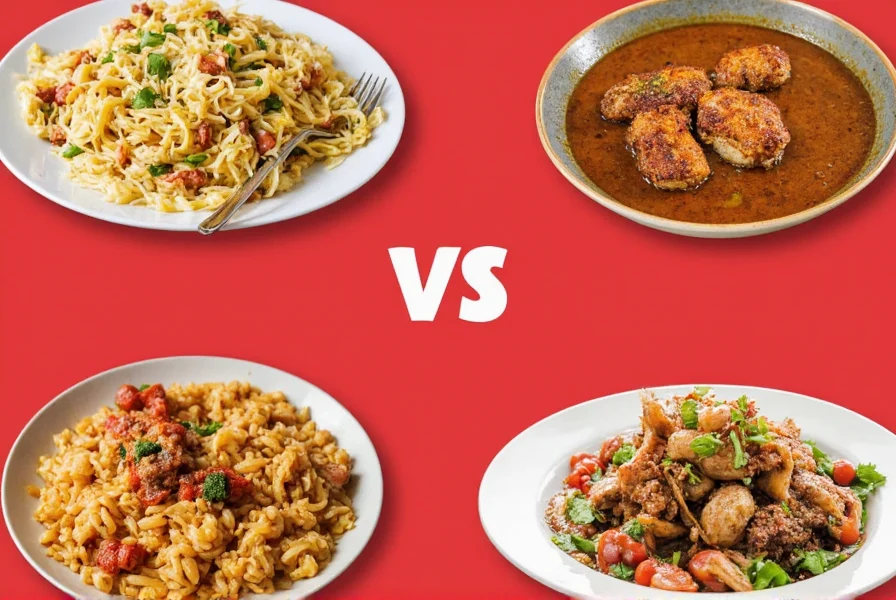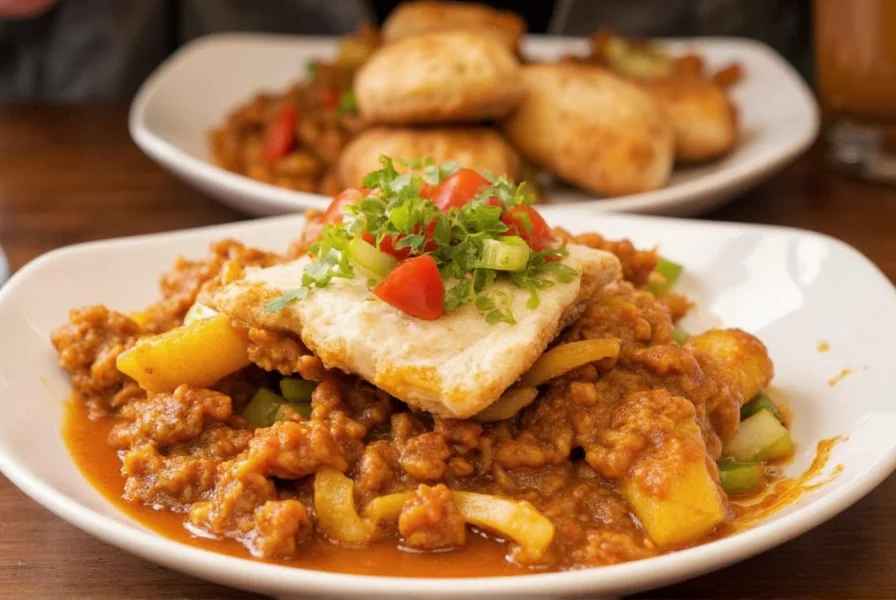Cajun vs Creole Food: A Spicy Showdown You Can’t Miss!
Ever stood in the spice aisle wondering whether you need Cajun or Creole seasoning? Or perhaps you’ve heard both terms thrown around at a BBQ joint and thought—wait, aren’t they basically the same thing?
Let me tell you—they’re not. While both hailing from Louisiana and sharing many ingredients, Cajun and Creole cuisines are as different as gumbo and jambalaya.
Table of Contents
- The Roots of Cajun & Creole Cuisine
- Cajun vs Creole: The Key Differences
- The Spice Breakdown: What Goes Into Each Seasoning?
- Classic Recipes Using Cajun & Creole Flavors
- Buying Guide: Best Cajun & Creole Seasonings on the Market
- Frequently Asked Questions
- Conclusion
The Roots of Cajun & Creole Cuisine
If food is culture, then Cajun and Creole cuisines are living history lessons served hot and spicy. Let’s take a quick trip back in time to see how these two legendary styles came to be.
Cajun Cuisine: Rustic & Rugged
Cajun food originated from the Acadians—French settlers who were expelled from Canada’s Maritime provinces by the British in the 1700s. They made their way to southern Louisiana, bringing with them hearty cooking techniques suited to life in the bayous and swamps.
Because of their rural lifestyle, Cajun dishes often rely on one-pot cooking methods like stewing and frying. Ingredients like pork, crawfish, and game were plentiful, so they became staples in Cajun cooking.
Creole Cuisine: Sophisticated & Cosmopolitan
Creole food, on the other hand, evolved in the urban heart of New Orleans. It was influenced by French, Spanish, African, German, and Italian settlers, creating a melting pot of flavors and techniques.
Creole cuisine tends to use more herbs and tomatoes than its Cajun counterpart. It also incorporates ingredients brought over through trade routes, such as exotic spices and imported seafood.
Cajun vs Creole: The Key Differences
At first glance, Cajun and Creole may seem interchangeable—but dig deeper, and you’ll find clear distinctions in flavor, origin, and ingredient choices.
| Feature | Cajun | Creole |
|---|---|---|
| Origin | Rural Louisiana (Acadian roots) | New Orleans (multi-cultural city cuisine) |
| Base Flavor | Spicy, smoky, bold | Herby, rich, complex |
| Tomatoes | Rarely used | Frequently used |
| Signature Dishes | Gumbo, Jambalaya, Étouffée | Po' Boy, Red Beans and Rice, Shrimp Creole |
| Main Herbs | Thyme, Bay Leaf, Oregano | Basil, Parsley, Thyme |
Think of it Like This:
- Cajun is your rugged uncle who lives off the land and likes his food with a kick.
- Creole is your worldly cousin who grew up in the city and appreciates refined flavors.
The Spice Breakdown: What Goes Into Each Seasoning?
The real magic lies in the blend of spices that give each style its signature punch. While there's some overlap, each has a unique personality when it comes to heat and herbaceousness.
Cajun Seasoning: Bold, Earthy, and Full of Fire
Cajun seasoning leans heavily on paprika, garlic powder, onion powder, black pepper, cayenne, and dried herbs like thyme and oregano. It brings a rustic, earthy warmth with a slow-building heat that can really make your mouth tingle.
Creole Seasoning: Bright, Herbal, and Balanced
Creole seasoning uses many of the same base ingredients but adds more fresh herbs like basil and parsley. It also commonly includes celery salt or dried celery flakes, giving it a slightly brighter and more herbal profile compared to Cajun spice.
| Spice | Cajun Use | Creole Use |
|---|---|---|
| Paprika | High | Moderate |
| Cayenne Pepper | High | Moderate |
| Garlic Powder | High | High |
| Oregano | High | Moderate |
| Thyme | High | High |
| Basil / Parsley | Low | High |
Pro Tip:
- Use Cajun seasoning when you want to pack a punch—especially with chicken, shrimp, or sausage.
- Reach for Creole seasoning when you want depth and aroma without overwhelming heat—perfect for stews and rice dishes.
Classic Recipes Using Cajun & Creole Flavors
Want to bring that Southern flair into your kitchen? Here are a few tried-and-true recipes to get you started—with notes on which seasoning makes the most sense.
Cajun Classic: One-Pan Cajun Chicken Pasta
This dish highlights the boldness of Cajun spice, blending tender chicken thighs with pasta, bell peppers, and garlic in a single pan.
- Ingredients: Boneless chicken thighs, bell peppers, garlic, Cajun seasoning, heavy cream, Parmesan, pasta
- Heat Level: 🔥🔥🔥🔥
- Why Cajun? Because you want every bite to scream flavor and spice!
Creole Classic: Shrimp Creole
A staple in Creole kitchens, this tomato-based dish features juicy shrimp cooked in a savory-sweet sauce with peppers, onions, and tomatoes.
- Ingredients: Large shrimp, canned tomatoes, green bell peppers, onions, Creole seasoning, Worcestershire sauce
- Flavor Profile: Rich, tangy, aromatic
- Why Creole? Because the tomatoes + herbs combo just wouldn’t work with Cajun.
Buying Guide: Best Cajun & Creole Seasonings on the Market
Ready to stock your spice rack? Here are our top picks for authentic Cajun and Creole seasonings—each tailored to different tastes and cooking styles.
Top 3 Cajun Seasonings
- Tony Chachere’s Original Extra Spicy Cajun Seasoning
- Features: High heat, balanced earthiness
- Best For: Grilling, roasting, gumbo
- Who Should Buy: Spice lovers who enjoy intense flavor
- Zatarain’s Cajun Seasoning
- Features: Slightly milder, family-friendly
- Best For: Jambalaya, étouffée, po’ boys
- Who Should Buy: Home cooks and families
- Slap Ya Mama Cajun Seasoning
- Features: Medium heat, all-natural blend
- Best For: Rubs, marinades, soups
- Who Should Buy: Grill masters and outdoor chefs
Top 3 Creole Seasonings
- Dale’s Seasoning
- Features: Garlic-forward, mild and aromatic
- Best For: Seafood boils, rice dishes
- Who Should Buy: Everyday cooks looking for versatility
- Old Bay Seasoning
- Features: Mild and herby, iconic Chesapeake roots
- Best For: Steamed crab, shrimp, fries
- Who Should Buy: Fans of seafood seasoning
- Emeril Lagasse Essence Creole Seasoning
- Features: Chef-grade, complex blend
- Best For: Restaurant-quality meals
- Who Should Buy: Home chefs and culinary enthusiasts

Pro Buying Tips:
- Check for “salt-free” options if you're watching sodium intake.
- Opt for organic or all-natural blends if you prefer clean eating.
- Buy small quantities first—you might discover you prefer one brand over another!
Frequently Asked Questions
Can I Substitute Cajun for Creole Seasoning?
You can—but the flavor will shift. If you swap Cajun for Creole, add a pinch of basil or parsley to balance it out. Conversely, if using Creole instead of Cajun, throw in a dash of cayenne to amp up the heat.
What Is the Most Popular Cajun Dish?
While opinions vary, **gumbo** is often cited as the king of Cajun dishes. Packed with protein and thickened with a dark roux, it’s a true representation of Cajun soul.
Is Gumbo Cajun or Creole?
Both! There are **Cajun-style gumbos** (darker roux, no tomatoes) and **Creole-style gumbos** (tomato-based, more herbs). So the answer depends on how it’s prepared.
Which Is Spicier—Cajun or Creole?
In general, **Cajun seasoning is spicier** because of its heavier use of cayenne and paprika. Creole focuses more on aromatic complexity than heat.
Where to Buy Authentic Cajun and Creole Seasoning?
- Local grocery stores (e.g., Walmart, Kroger, Whole Foods)
- Online marketplaces (Amazon, Etsy for artisan brands)
- Louisiana specialty shops (Tony Chachere’s, Slap Ya Mama official site)
Conclusion: Which One’s Right for You?
Whether you lean toward the bold fire of Cajun seasoning or the elegant complexity of Creole, one thing’s certain: both offer unforgettable flavor journeys rooted in Louisiana tradition.
So next time you’re standing in front of the spice rack, ask yourself: Are you feeling wild and daring today… or sophisticated and curious? That should help you decide between Cajun and Creole.
Now go forth, grab that seasoning, and let your taste buds travel deep into the heart of the South!
Got a favorite Cajun or Creole recipe? Drop it in the comments below—we’d love to hear what’s cooking in your kitchen!











 浙公网安备
33010002000092号
浙公网安备
33010002000092号 浙B2-20120091-4
浙B2-20120091-4